In the dynamic world of culinary tools, knife sets stand as a cornerstone, essential for both home kitchens and professional culinary environments. As 2024 unfolds, the evolution in knife set design and functionality mirrors the growing sophistication of cooking techniques and consumer expectations. These sets, encompassing a range of blades from versatile chef’s knives to specialized santoku and utility knives, cater to a myriad of cutting tasks. Their significance extends beyond mere functionality; they represent a blend of art and science, with each set crafted to offer precision, efficiency, and aesthetic appeal. This blend not only enhances the culinary experience but also serves as a pivotal factor in the decision-making process for those procuring these tools, ensuring that every slice and dice contributes to the creation of culinary masterpieces.
Table of Contents:
1. Knife set varieties and their applications
2. Analyzing the 2024 knife set market
3. Key considerations for knife set selection
4. Leading knife set models and their features
5. Concluding insights
Knife set varieties and their applications
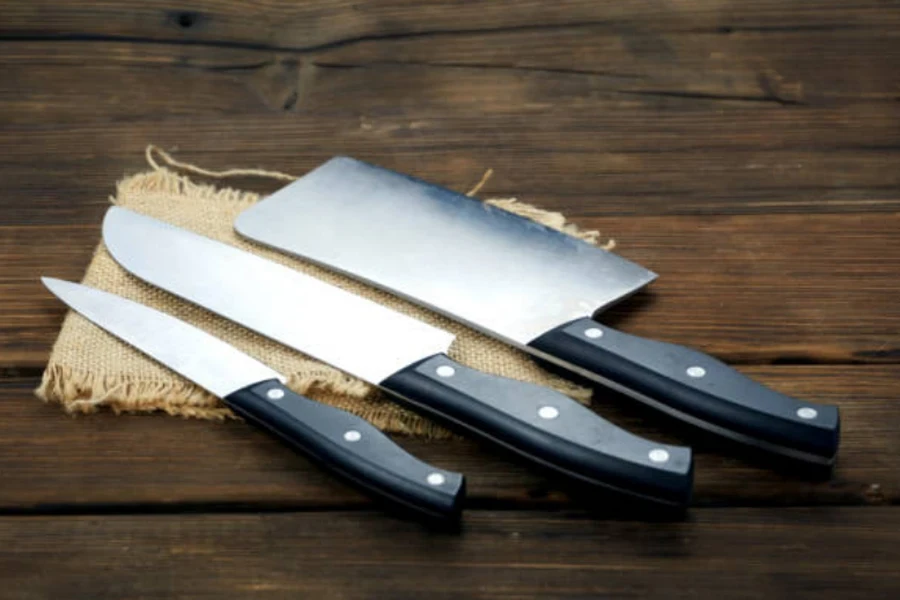
In the realm of culinary tools, the diversity of knife sets reflects the intricate nature of cooking practices. Knife sets, a fundamental component in kitchen arsenals, come in various types, each designed to cater to specific culinary needs. Among the most prominent are chef’s knives, santoku knives, and utility knives, each with unique characteristics and purposes.
Differentiating knife set types
Chef’s knives, often considered the backbone of kitchen knife sets, are known for their versatility. These knives typically feature a broad blade ranging from six to twelve inches in length, making them suitable for a wide array of tasks, from chopping vegetables to slicing meats. The design of a chef’s knife balances agility and power, providing a reliable tool for both precise and heavy-duty cutting tasks.
Santoku knives, originating from Japan, offer a distinct design characterized by a shorter, thinner blade with a flatter cutting edge. This design facilitates a more precise cutting motion, ideal for slicing, dicing, and mincing. Santoku knives are particularly adept at handling fish and vegetables, offering a clean cut with minimal sticking due to their granton edge – a series of scallops along the blade’s side.
Utility knives, smaller than chef’s knives but larger than paring knives, fill the gap for intermediate tasks. These knives usually measure between four and seven inches and are perfect for tasks that require more precision than a chef’s knife but more heft than a paring knife. They excel in slicing smaller fruits and vegetables, trimming meat, and even sandwich preparation.
Usage scenarios for each knife type
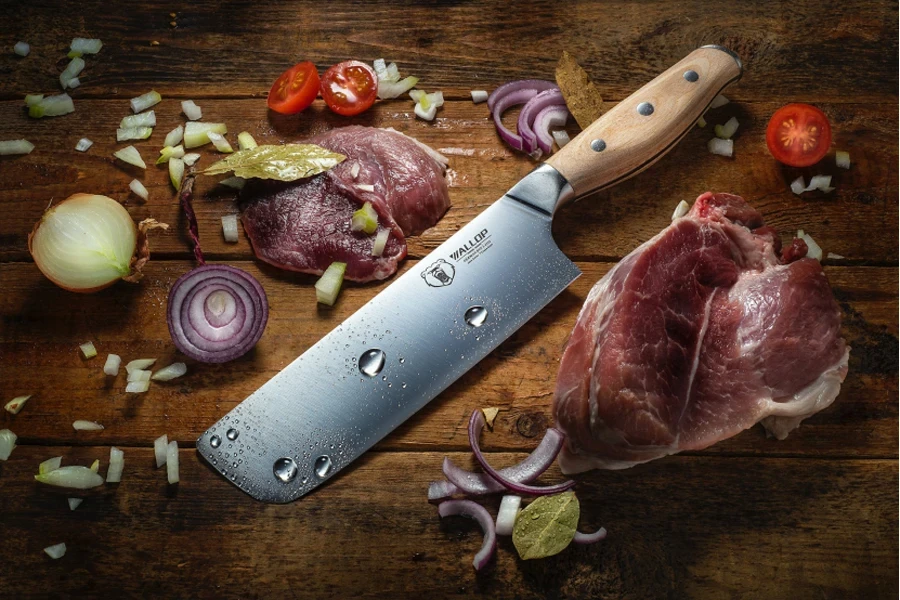
Each knife type finds its place in various culinary scenarios. Chef’s knives, with their broad and versatile blades, are the go-to for most chopping, slicing, and mincing tasks in the kitchen. They are the preferred choice for handling larger ingredients like meats and dense vegetables. In contrast, santoku knives, with their thinner and shorter blades, are ideal for precision tasks like finely chopping herbs, julienning vegetables, or preparing delicate cuts of fish. Their design ensures minimal tearing or bruising of the ingredients.
Utility knives, straddling the line between a chef’s and a paring knife, are particularly useful for more intricate tasks that require a bit more control than a chef’s knife can offer but less finesse than a paring knife. They are often reached for when preparing fruits for garnishes, slicing smaller cuts of meat, or even for more detailed vegetable prep work.
Understanding the nuances of these knife types and their specific applications is crucial for culinary professionals. It ensures that the right tool is chosen for the right task, leading to more efficient and precise preparation. This knowledge is not only vital for culinary experts but also for those responsible for equipping kitchens with the appropriate tools, ensuring that each knife set purchased is well-suited to the culinary tasks it will encounter.
Analyzing the 2024 knife set market
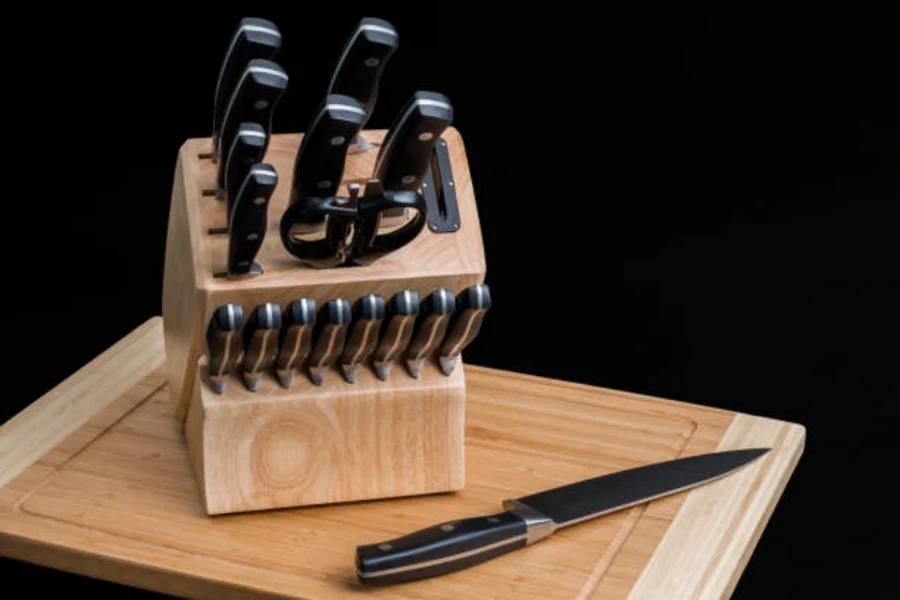
The knife set market in 2024 presents a landscape shaped by evolving consumer preferences and the relentless pursuit of quality in both materials and craftsmanship. This evolution reflects a deeper understanding of the culinary arts and the tools that enhance them.
Current market trends and consumer preferences
The global knife market, encompassing various types including knife sets, was valued at USD 3.81 billion in 2021. Experts project this market to expand at a compound annual growth rate (CAGR) of 6.0% from 2022 to 2030. This growth trajectory suggests a significant increase in market size, reaching approximately USD 6.41 billion by the end of 2030.
Recent trends in knife set design indicate a shift towards multifunctionality and aesthetic appeal. Consumers are increasingly seeking knife sets that not only perform a variety of tasks but also complement the visual appeal of their kitchen spaces. This trend is evident in the growing popularity of sets that include a mix of traditional and specialized knives, catering to both everyday cooking and more niche culinary endeavors. The demand for sets that include a chef’s knife, a santoku, and a utility knife, as highlighted in the previous section, underscores this trend. Additionally, there is a noticeable inclination towards eco-friendly and sustainable materials, reflecting a broader societal shift towards environmental consciousness.
Impact of material and craftsmanship on market dynamics
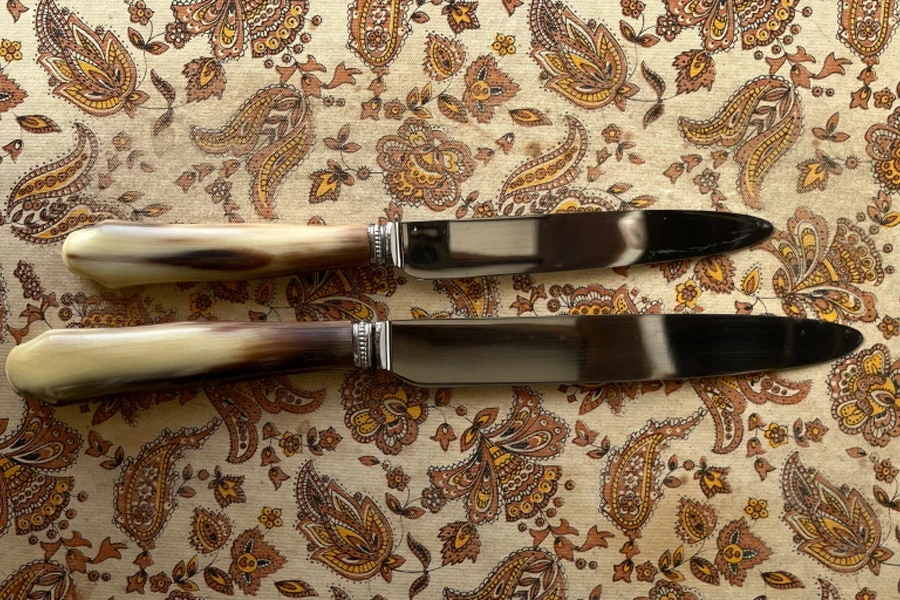
The choice of materials and the level of craftsmanship play pivotal roles in the dynamics of the knife set market. High-carbon stainless steel remains a preferred material for its durability and ease of maintenance, as seen in the popularity of brands like Wüsthof and Global. These materials not only ensure longevity but also provide the sharpness and precision that culinary professionals seek. Furthermore, the craftsmanship involved in producing these knife sets, from the forging process to the final finishing touches, significantly impacts their market value. Sets that demonstrate superior craftsmanship, such as those with hand-polished and hand-sharpened blades, command a higher market position, resonating with consumers who value quality and precision in their culinary tools.
The interplay between material quality and craftsmanship has led to a market that values authenticity and performance. Knife sets that showcase exceptional craftsmanship, using materials that promise durability and efficiency, align well with the expectations of today’s discerning consumers. This trend is not just a reflection of consumer preferences but also an indicator of the market’s direction towards higher quality standards.
In summary, the knife set market in 2024 is characterized by a discerning consumer base that values multifunctionality, aesthetic appeal, and sustainability. The market dynamics are significantly influenced by the choice of materials and the level of craftsmanship, with a clear preference for high-quality, durable, and efficiently designed knife sets. This landscape presents an opportunity for those in the industry to align their offerings with these evolving market trends, ensuring that their products meet the sophisticated needs of modern culinary enthusiasts.
Key considerations for knife set selection
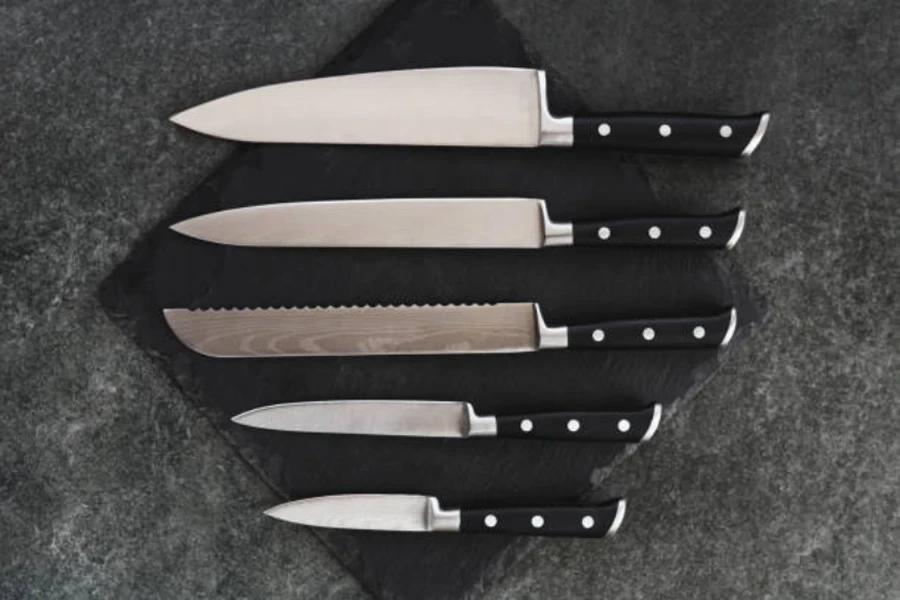
Selecting the right knife set involves a meticulous evaluation of quality, durability, ergonomic design, and aesthetics. These factors are crucial in determining the suitability of a knife set for both professional and personal kitchen environments.
Evaluating knife quality and durability
When evaluating the quality and durability of knife sets, several detailed criteria come into play. These factors are essential in ensuring that the selected knife sets meet the high standards required for both professional and home use.
The material of the blade is a primary indicator of quality. High-carbon stainless steel is often the preferred choice due to its balance of durability, edge retention, and resistance to corrosion. For example, Wusthof’s Gourmet series and Global’s high-end stamped knives use such materials, offering a blend of sharpness and longevity. The construction method, whether forged or stamped, also impacts the knife’s durability. Forged knives, created from a single piece of molten steel, are known for their sturdiness and less flexibility, which makes them less prone to bending over time. In contrast, stamped knives, cut from a large sheet of metal, are generally lighter and can be equally durable if crafted by high-end manufacturers.
The heat treatment process is another critical factor. It affects the hardness of the blade, with an ideal range being between 55 and 60 Rockwell hardness. This range ensures that the knife is hard enough to maintain a sharp edge while being flexible enough to resist chipping or breaking. The edge of the blade and its ability to retain sharpness are also crucial. A well-designed knife should have a finely honed edge that can be easily sharpened and maintain its sharpness over prolonged use.
The bolster, the thick band of steel on forged knives, contributes to the balance and hand protection. A well-crafted bolster indicates attention to safety and ergonomics. The tang, the part of the blade extending into the handle, is another aspect to consider. A full tang, where the blade runs through the entire handle, offers better balance and strength.
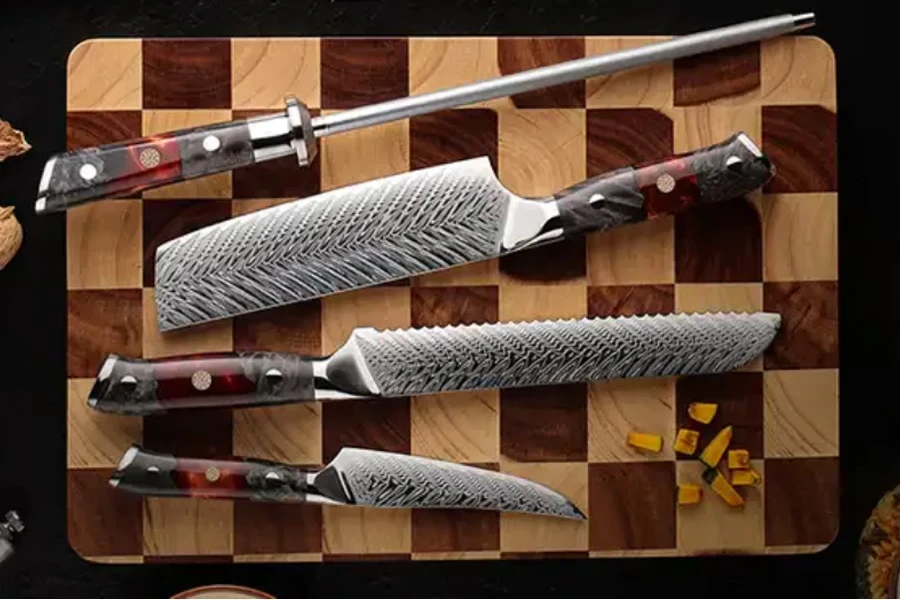
In addition to the blade, the handle’s material and design significantly affect the knife’s overall quality and durability. Handles made from materials like wood, metal, or composite affect the grip and feel of the knife. Ergonomically designed handles that fit comfortably in the hand without causing strain are indicative of high-quality craftsmanship.
In summary, evaluating the quality and durability of knife sets involves a thorough examination of the blade’s material, construction method, heat treatment, edge retention, bolster, tang, and handle design. These factors collectively determine the knife’s performance, safety, and longevity, making them essential criteria in the selection process.
Importance of ergonomic design and aesthetics
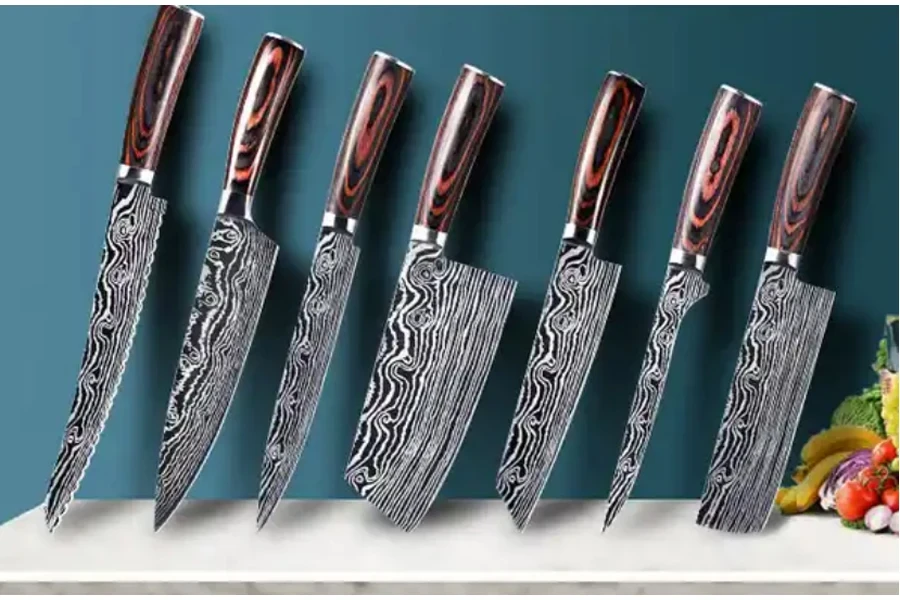
In the selection of knife sets, the importance of ergonomic design and aesthetics cannot be overstated. These features play a crucial role in enhancing both the functionality and visual appeal of the knives, making them essential considerations for culinary professionals and enthusiasts alike.
Ergonomic design in knife sets focuses on the comfort and efficiency of use. A well-designed handle is crucial for reducing hand fatigue and increasing control during cutting tasks. For example, knives with oval-shaped handles are often recommended for their ergonomic benefits. They provide a comfortable grip that aligns with the natural contours of the hand, reducing strain during prolonged use. Additionally, the material of the handle contributes to the overall ergonomics. Wood or metal handles are known for providing a good grip, while plastic or synthetic handles can become slippery, especially when wet.
The visual appeal of knife sets is another significant factor, particularly in modern culinary settings where presentation is key. Aesthetically pleasing knife sets not only enhance the look of a kitchen but also reflect the user’s personal style. For instance, the garnishing knife set, with its specialized blades designed for intricate and decorative cuts, adds an artistic touch to dishes, creating visually stunning presentations. These sets often include knives like citrus zesters, melon ballers, and decorating knives, each with unique blade designs that contribute to their visual appeal.
In contrast, regular kitchen knives prioritize functionality and versatility. These knives, including chef’s, utility, and paring knives, are designed for a broad range of cutting tasks. While they may not offer the same level of artistic presentation as garnishing knife sets, their standard blade designs focus on durability and versatility, making them suitable for various cooking and food preparation needs.
In conclusion, when selecting knife sets, considering the ergonomic design and aesthetics is essential. Ergonomically designed handles ensure comfort and control, while visually appealing knives enhance the overall culinary experience. Whether it’s a garnishing knife set for artistic presentation or a set of regular kitchen knives for everyday cooking, the right balance of these elements can significantly elevate the functionality and style of a kitchen.
Leading knife set models and their features
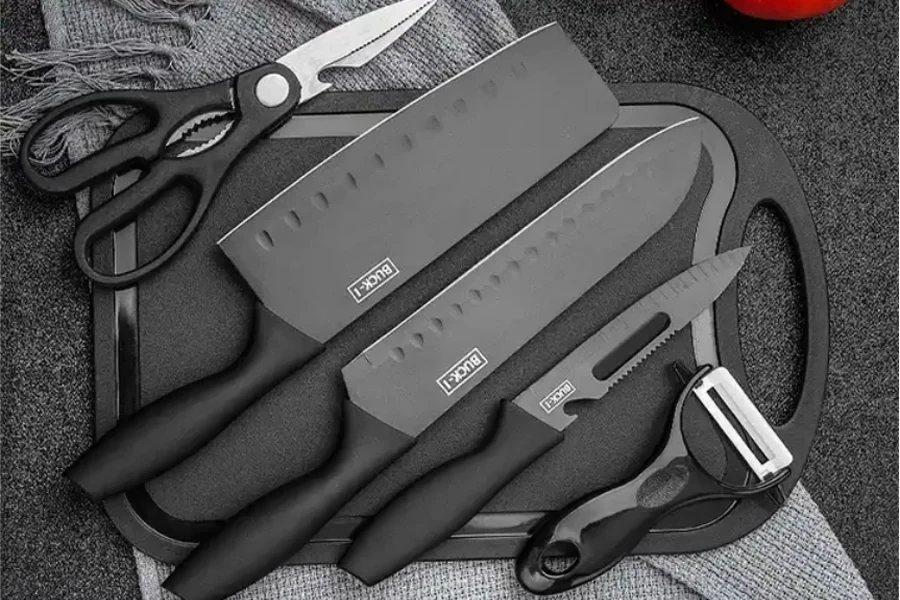
In 2024, the knife set market is characterized by a range of top-rated models, each offering unique features and benefits. Renowned brands like Wüsthof, Cangshan, Global, and others continue to dominate the scene, providing knife sets that cater to both professional chefs and culinary enthusiasts.
Overview of top-rated knife sets in 2024
Wüsthof Classic Ikon Series: Renowned for its exceptional craftsmanship, the Wüsthof Classic Ikon series stands out with its precision-forged high-carbon stainless steel blades. This series is particularly celebrated for its durability and edge retention. The ergonomic handle design, coupled with a double bolster for excellent balance, makes these knives a favorite among professional chefs. The set typically includes essential knives like the 8-inch chef’s knife, a versatile paring knife, and a serrated bread knife, catering to a wide range of culinary tasks.
Cangshan S1 Series: Merging Chinese craftsmanship with contemporary design, the Cangshan S1 series is notable for its sleek aesthetic and functional prowess. The knives in this series are crafted from high-alloy Swedish Sandvik 14C28N Steel, known for its remarkable sharpness and edge resilience. The series often features unique, ergonomically designed African Blackwood handles, providing comfort and control during extended use. The set usually includes a diverse selection of knives, each tailored for specific culinary applications.
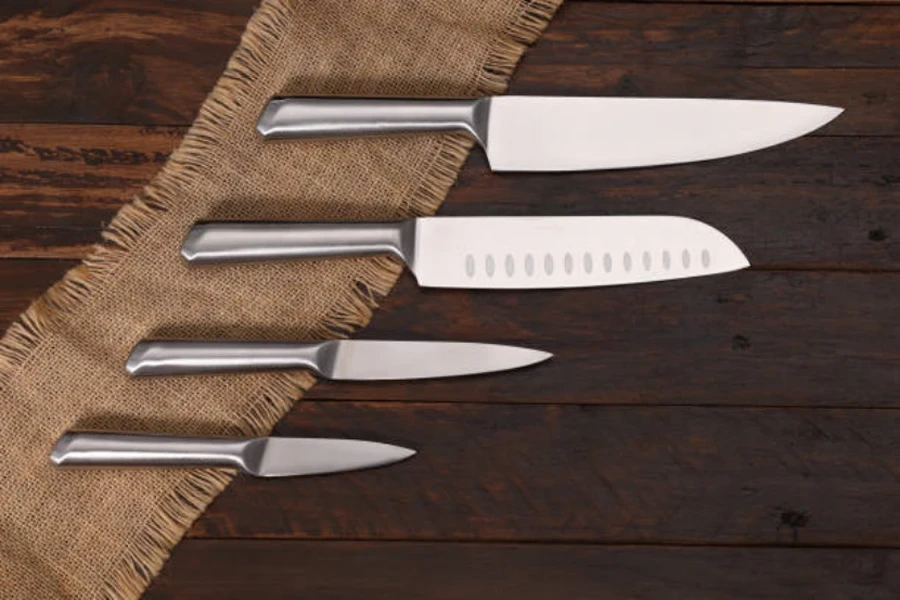
Global G Series: The Global G series is a testament to Japanese precision and innovation. These knives are distinguished by their Cromova 18 stainless steel construction, offering a unique combination of sharpness, durability, and corrosion resistance. The series is known for its lightweight design, with hollow handles filled with sand for optimal balance. The thin, razor-sharp blades are perfect for detailed and precise cutting tasks, making the set a popular choice for chefs who prioritize precision and ease of handling.
Henckels International Statement Knife Block Set: Henckels International is synonymous with quality and reliability. The Statement Knife Block Set from Henckels features knives made from high-quality stainless steel, ensuring longevity and consistent performance. The traditional triple-rivet handles offer a classic look and a comfortable grip. This comprehensive set typically includes a range of knives, such as a chef’s knife, a bread knife, and steak knives, all organized in a stylish wooden block, making it a versatile choice for both home cooks and professional kitchens.
Shun Premier Knife Block Set: Shun’s Premier series is celebrated for its exquisite craftsmanship and aesthetic appeal. The knives in this set are crafted using layered Damascus steel, known for its strength and distinctive pattern. The hand-hammered finish not only adds to the beauty of the knives but also provides a non-stick surface. The set is often equipped with a range of knives, each featuring a contoured PakkaWood handle that ensures comfort and control. This set is ideal for those who appreciate the art of knife-making and desire a blend of performance and elegance in their culinary tools.
Each of these knife sets in 2024 stands out for its unique combination of quality, design, and functionality, catering to the diverse needs and preferences of culinary professionals and enthusiasts.
Comparative analysis of features and benefits
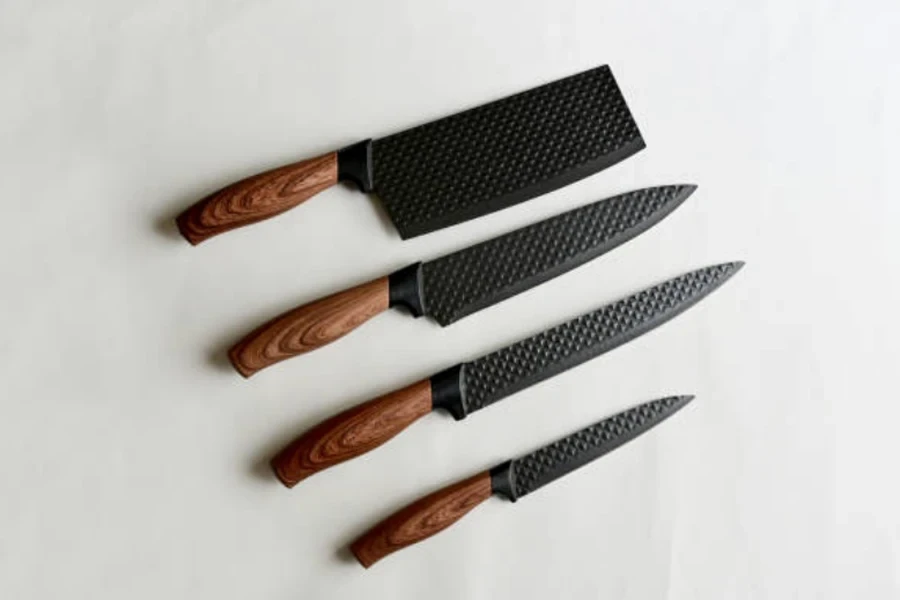
In 2024, the leading knife sets from brands like Wüsthof, Cangshan, Global, Henckels, and Shun offer a range of features and benefits. Here’s a detailed comparative analysis based on different features:
Blade material and construction
Wüsthof Classic Ikon Series uses high-carbon stainless steel, ensuring durability and resistance to corrosion. The precision-forged construction offers a balance between flexibility and robustness.
Cangshan S1 Series employs Swedish Sandvik 14C28N Steel, known for its exceptional sharpness and edge retention, making it ideal for precise cuts.
Global G Series features Cromova 18 stainless steel, which is resistant to rust and stains, and maintains its edge well over time.
Henckels International Statement Knife Block Set and Shun Premier Knife Block Set both use high-quality stainless steel, but Shun incorporates layered Damascus steel for added strength and a unique pattern on the blade.
Handle design and ergonomics
Wüsthof offers a double bolster for balance and an ergonomic handle for comfortable grip during extended use.
Cangshan’s African Blackwood handles are ergonomically designed for comfort and control, suitable for prolonged culinary tasks.
Global’s hollow handles filled with sand provide a unique balance, making the knives lightweight and easy to maneuver.
Henckels features traditional triple-rivet handles, offering a classic and sturdy grip.
Shun’s contoured PakkaWood handles are designed for comfort and control, fitting naturally in the hand.
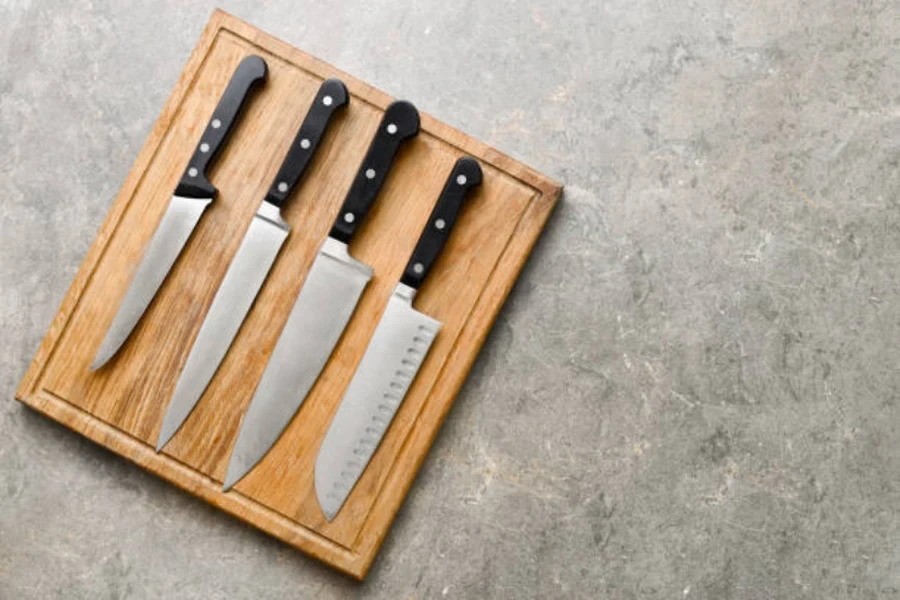
Sharpness and edge retention
Wüsthof’s blades are known for their long-lasting sharpness, requiring less frequent honing.
Cangshan and Global knives, with their high-quality steel, offer superior sharpness right out of the box and maintain their edge for extended periods.
Henckels knives provide a good balance between sharpness and durability, suitable for a variety of kitchen tasks.
Shun’s layered Damascus steel not only adds to the sharpness but also helps in retaining the edge for a longer time.
Aesthetic appeal
Wüsthof’s classic design appeals to those who prefer a traditional look in their kitchen tools.
Cangshan’s modern Scandinavian design stands out for its sleek and contemporary appearance.
Global’s all-stainless design offers a modern and minimalist aesthetic.
Henckels provides a more conventional appearance with its wooden block and classic handle design.
Shun’s hand-hammered finish and layered steel construction make it a visually striking choice for those who value aesthetics in their kitchenware.
Versatility and range of knives
Wüsthof and Henckels offer comprehensive sets that include a variety of knives for different culinary tasks, making them versatile choices for any kitchen.
Cangshan and Shun focus on providing specialized knives that cater to specific tasks, ideal for those who have particular preferences in their cooking style.
Global’s sets are known for their precision and are particularly favored by those who require knives for detailed and delicate tasks.
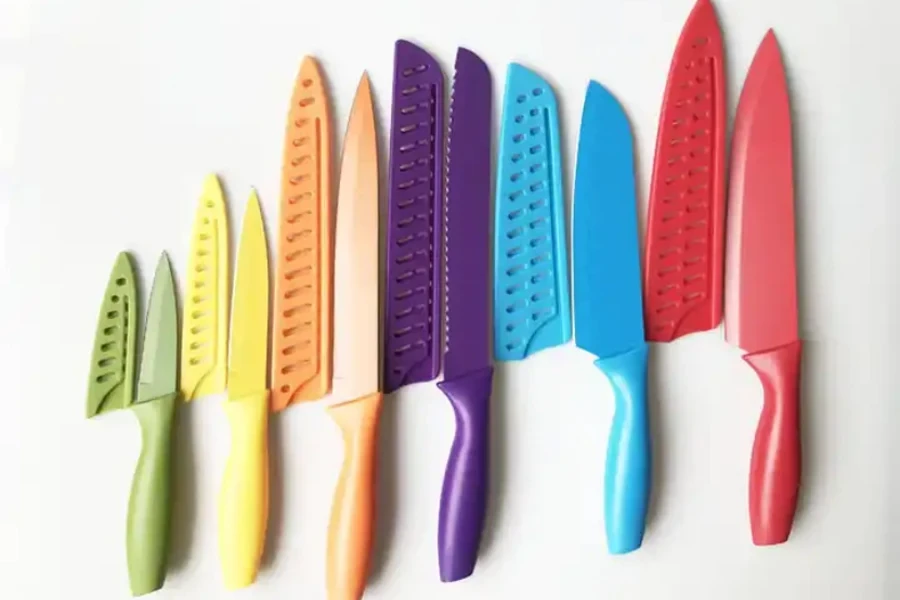
In summary, each knife set brand offers a unique combination of features, catering to different preferences in terms of material quality, handle ergonomics, sharpness, aesthetic appeal, and versatility. The choice depends on individual needs, whether it’s for professional culinary use or everyday cooking at home.
Concluding insights
Selecting the right knife set for inventory in 2024 requires a nuanced understanding of various factors, including material quality, ergonomic design, and aesthetic appeal. Brands like Wüsthof, Cangshan, Global, Henckels, and Shun each offer unique attributes, from Wüsthof’s durable construction to Cangshan’s modern design and Global’s precision. The choice hinges on balancing functionality with style, ensuring that the selected sets meet diverse culinary needs while appealing to different consumer preferences. This careful selection process is vital for online retailers aiming to cater to the sophisticated and varied demands of today’s culinary market.




